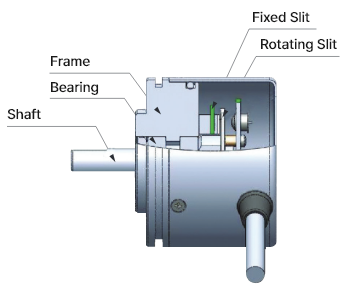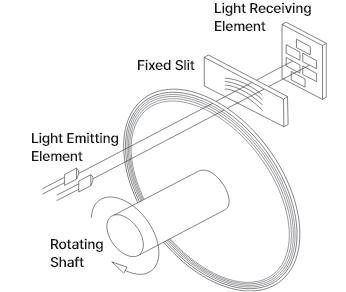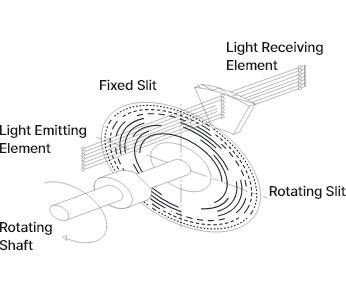R&D
FA Leading Company KWANGWOO
We aim to give full satisfaction to all our customers by making better productions and services.

Rotary Encoder
Definition
- Rotary Encoder is a sensor that detects and converts mechanical transfer or displacement into electric signal. It detects the position, speed, angle of FA system by means of converting analog signal generated from a revolution of the shaft into digital signal by the internal fixed circuit.
Characteristics
- High Resolution
- Easy to Record The Measuring Value
- High Stability
Since it is digital output unlike analog output, it is highly stable because it is not affected even if there is noise below a certain level. - Various Kinds of Type
There are various kinds of rotary encoder with wide resolution, appearance.

Structure
- Rotary encoder is basically composed of mechanical part, light receiving / light emitting part, circuit part but it may be different depending on the model.
- The mechanical part is composed by shaft, frame, bearing.
- The light receiving / light emitting part are composed by light receiving and light emitting element, disk / mask.
- The circuit part is composed by the circuit which formalizes the signal generated from light receiving element.

Principle
Incremental Encoder
The light generated from light emitting element passes through rotating and fixed slit.
The light energy is converted into current through light receiving element and passes through fixed-waved circuit & output circuit and output as two rectangular pulses which have different phase of 1/4 cycle.
- It is output as rectangular waveform depending on the amount of rotating displacement of the shaft.
- The external counter figures out the number of pulses and the amount of rotating displacement is detected.
- You have to set the origin point to find a certain rotating displacement and add the number of pulse from the origin point accumulatively.
- You can add the extra circuit to the output circuit of rotary encoder and improve the electrical resolution by increasing the output pulse 2 times, 4 times.
- You have to find the origin point newly when the power is turned on after power off or power failure.
Absolute Encoder

Principle
The basic principle of absolute encoder is the same as incremental encoder. In case of incremental encoder, two output is two rectangular pulses of different phase, while in case of absolute encoder, it is output as digital code(Binary, BCD, Gray Code).
- The amount of rotating displacement is output as parallel 2n the more output code bits, the higher the resolution.
- It detects the rotating position by reading the output code directly.
- Once the origin of input rotating shaft is fixed, the rotating angle with the origin position as the coordinate origin is always outputted as digital code.
- It always maintains the absolute position when the power is turned on after power off or power failure.
 Rotary Encoder Incremental Type
Rotary Encoder Incremental Type Absolute Magnetic Encoder
Absolute Magnetic Encoder Pulse Generator
Pulse Generator Resolver
Resolver Laser Scan Sensor
Laser Scan Sensor Light Guide
Light Guide Light Source
Light Source Information display device
Information display device